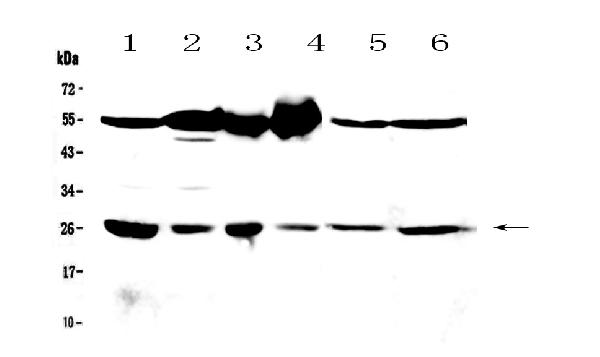Product Info Summary
| SKU: | PROTP21266 |
|---|---|
| Size: | Starting from 20ug |
| Source: | E. coli |
| Application: | Enzyme Activity, SDS-PAGE |
Customers Who Bought This Also Bought
Product info
Product Name
Human GSTM3 Recombinant Protein
View all GSTM3 recombinant proteins
SKU/Catalog Number
PROTP21266
Size
Starting from 20ug
Tag
His-Tag
Description
Human GSTM3 Recombinant Protein expressed in E. coli with His-tag. Sequence domain: 1-225aa. Application(s): Enzyme Activity, SDS-PAGE.
Storage & Handling
Can be stored at 2°C to 8°C for 1 week. For long-term storage, aliquot and store at -20°C to -80°C. Avoid repeated freeze-thaw cycles. (Ships with gel ice.)
Cite This Product
Human GSTM3 Recombinant Protein (Boster Biological Technology, Pleasanton CA, USA, Catalog # PROTP21266)
Form
Liquid
Formulation
20mM Tris-HCl buffer (pH 8.0) containing 1mM DTT, 10% glycerol, 0.1M NaCl
Concentration
1mg/ml (determined by Bradford assay)
Purity
> 95% by SDS-PAGE
Predicted MW
29.1 kDa (249aa) confirmed by MALDI-TOF
Amino Acid Sequence
Human, P21266, 1-225aa; MGSSHHHHHH SSGLVPRGSH MGSHMSCESS MVLGYWDIRG LAHAIRLLLE FTDTSYEEKR YTCGEAPDYD RSQWLDVKFK LDLDFPNLPY LLDGKNKITQ SNAILRYIAR KHNMCGETEE EKIRVDIIEN QVMDFRTQLI RLCYSSDHEK LKPQYLEELP GQLKQFSMFL GKFSWFAGEK LTFVDFLTYD ILDQNRIFDP KCLDEFPNLK AFMCRFEALE KIAAYLQSDQ FCKMPINNKM AQWGNKPVCBioactivity
Specific activity is > 15,000 pmol/min/ug, and is defined as the amount of enzyme that conjugate 1.0 u mole of 1-chloro-2,4-dinitrobenzene (CDNB) with reduced glutathione per minute at pH 6.5 at 25°C.Assay dilution & Images
Validation Images & Assay Conditions

Click image to see more details
3ug by SDS-PAGE under reducing condition and visualized by coomassie blue stain.
Protein Target Info & Infographic
Gene/Protein Information For GSTM3 (Source: Uniprot.org, NCBI)
Gene Name
GSTM3
Full Name
Glutathione S-transferase Mu 3
Weight
29.1 kDa (249aa) confirmed by MALDI-TOF
Superfamily
GST superfamily
Alternative Names
Glutathione S-transferase mu 3, GST5, GSTB, GSTM3-3, GTM3 GSTM3 GST5, GSTB-3, GTM3, GSTM3 glutathione S-transferase mu 3 glutathione S-transferase Mu 3|GST class-mu 3|S-(hydroxyalkyl)glutathione lyase M3|brain GST|brain type mu-glutathione S-transferase|epididymis secretory sperm binding protein|glutathione S-alkyltransferase M3|glutathione S-aralkyltransferase M3|glutathione S-aryltransferase M3|glutathione S-transferase M3 (brain)|glutathione S-transferase mu 3 (brain)|glutathione S-transferase, Mu-3|hGSTM3-3
*If product is indicated to react with multiple species, protein information is based on the gene entry specified above in "Species".For more info on GSTM3, check out the GSTM3 Infographic

We have 30,000+ of these available, one for each gene! Check them out.
In this infographic, you will see the following information for GSTM3: database IDs, superfamily, protein function, synonyms, molecular weight, chromosomal locations, tissues of expression, subcellular locations, post-translational modifications, and related diseases, research areas & pathways. If you want to see more information included, or would like to contribute to it and be acknowledged, please contact us at [email protected].
Specific Publications For Human GSTM3 Recombinant Protein (PROTP21266)
Loading publications
Recommended Resources
Here are featured tools and databases that you might find useful.
- Boster's Pathways Library
- Protein Databases
- Bioscience Research Protocol Resources
- Data Processing & Analysis Software
- Photo Editing Software
- Scientific Literature Resources
- Research Paper Management Tools
- Molecular Biology Software
- Primer Design Tools
- Bioinformatics Tools
- Phylogenetic Tree Analysis
Customer Reviews
Have you used Human GSTM3 Recombinant Protein?
Submit a review and receive an Amazon gift card.
- $30 for a review with an image
0 Reviews For Human GSTM3 Recombinant Protein
Customer Q&As
Have a question?
Find answers in Q&As, reviews.
Can't find your answer?
Submit your question



